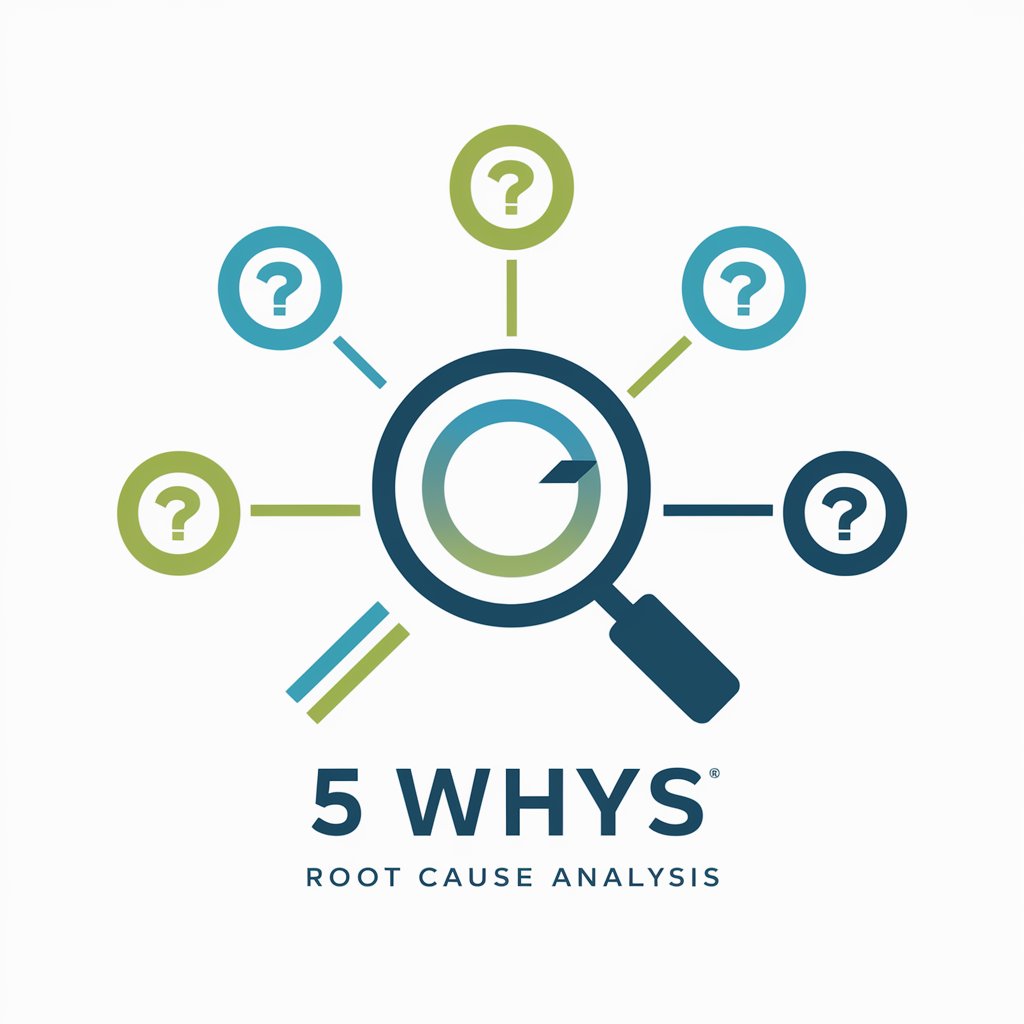"5 Whys" Root Cause Analysis - Simple Root Cause Analysis

Hi! Let's dive into your problem to uncover the root causes.
Uncover Root Causes with AI-Powered Analysis
Why do you think this issue is occurring?
Why did this problem arise in the first place?
Why do you believe this challenge persists?
Why has this situation developed as it has?
Get Embed Code
Introduction to '5 Whys' Root Cause Analysis
The '5 Whys' Root Cause Analysis is a problem-solving method developed within the realms of Lean management and Six Sigma to facilitate the identification and elimination of the root causes of problems or defects. The technique involves asking the question 'Why?' repeatedly, typically five times or until the underlying cause of a problem is identified. This method emphasizes a deeper understanding of issues rather than treating superficial symptoms, promoting long-term solutions over quick fixes. The simplicity of the '5 Whys' makes it accessible across various disciplines, not requiring complex statistics or tools. For example, in a manufacturing setting, if a machine stops working ('the problem'), the first 'Why' might be 'because a fuse blew.' Asking 'Why' again might reveal that the fuse blew due to an overload, and further questioning could lead to identifying that the overload was caused by a part being installed incorrectly. The iterative process continues until the root cause is uncovered, often leading to insights that prevent recurrence of the issue. Powered by ChatGPT-4o。

Main Functions of '5 Whys' Root Cause Analysis
Problem Identification
Example
Identifying why a software application frequently crashes.
Scenario
In a tech company, developers use the '5 Whys' to drill down into crash reports, uncovering that the crashes are due to a specific feature's code. Further questioning leads to the realization that the code lacks error handling for unusual user inputs, which is then identified as the root cause and subsequently fixed.
Process Improvement
Example
Understanding why a delivery process is consistently delayed.
Scenario
A logistics company applies the '5 Whys' to discover that delays are often caused by manual entry errors in their tracking system. Digging deeper, they find that the user interface of the system is not intuitive, leading to frequent mistakes. The root cause is identified as the poor design of the system interface, prompting a redesign to improve accuracy and efficiency.
Quality Control
Example
Analyzing the cause of defects in a product line.
Scenario
A manufacturing plant uses the '5 Whys' to investigate the high defect rate in one of its products. The initial 'Why' points to assembly errors, which upon further investigation are linked to inadequate training of new employees. The root cause analysis leads to the implementation of a more comprehensive training program, reducing defects significantly.
Ideal Users of '5 Whys' Root Cause Analysis Services
Project Managers
Project managers in various industries can use '5 Whys' to dissect project delays, budget overruns, or quality issues, ensuring projects are completed efficiently and effectively.
Quality Assurance Professionals
Quality assurance teams across manufacturing, software development, and service industries employ '5 Whys' to trace product or service defects back to their origins, leading to higher quality outputs.
Operational Managers
Operational managers utilize '5 Whys' to streamline processes, enhance productivity, and reduce costs by identifying inefficiencies and their root causes within operational workflows.
Healthcare Administrators
Healthcare administrators apply '5 Whys' to analyze patient care issues, procedural errors, or system inefficiencies, aiming to improve patient outcomes and operational efficiency.

How to Use '5 Whys' Root Cause Analysis
Start Your Analysis
Begin by accessing a root cause analysis tool online; for instance, you can start a free trial at yeschat.ai without needing to log in or subscribe to ChatGPT Plus.
Identify the Problem
Clearly define the problem you're experiencing. Write down a concise statement of the issue at hand.
Ask 'Why?' Five Times
Starting with the problem statement, ask 'Why?' to identify the cause of the issue. Repeat this process up to five times to drill down to the root cause.
Analyze Responses
Carefully analyze the responses to each 'Why?' to ensure they logically lead to the next level of cause.
Implement Corrective Actions
Once the root cause is identified, develop and implement corrective actions to address the underlying issue.
Try other advanced and practical GPTs
Theses Agriculture & Veterinary Sciences UK
Unlocking Agriculture & Veterinary Research

Script Coder
Empowering Script Creation with AI

مبدع الأفكار
Empowering Creativity with AI

Epic Questmaster
Craft your epic saga with AI

Hypnosis Helper
Unlocking Potential with AI-Powered Hypnosis

SCP Infinite
Unveiling the SCP Universe, AI-powered.

Klarspråk - GPT
Simplify Texts with AI Power

OpenStorytelling Visualizer
Bringing Stories to Life with AI

Career Advisor
Empowering your career journey with AI

Roman Kozak's Secretary
Smart AI Assistance, Tailored to You

APOe4 GPT
Empowering Knowledge on APOe4 Genetics

Maximizing Stakeholder Engagement in EDS
Empowering EDS Projects with AI-Driven Stakeholder Engagement

Detailed Q&A about '5 Whys' Root Cause Analysis
What is '5 Whys' Root Cause Analysis?
'5 Whys' Root Cause Analysis is a problem-solving method that involves asking 'Why?' five times or more to drill down into the root cause of a problem, starting from a problem statement and working backward to uncover underlying issues.
When should '5 Whys' be used?
It's most effective in scenarios where a clear line of causality is present, such as process or system failures, operational inefficiencies, and technical problems in project management, manufacturing, or software development.
How does '5 Whys' differ from other analysis tools?
Unlike complex analytical tools that require statistical analysis, '5 Whys' is simpler and more intuitive, making it accessible for teams without specialized knowledge. It focuses on human factors and process systems, promoting direct, straightforward problem-solving.
Can '5 Whys' be applied to personal goals or issues?
Absolutely. While commonly used in professional settings, '5 Whys' can be equally effective for personal improvement, such as addressing habits, productivity challenges, or interpersonal issues by identifying underlying causes and actionable solutions.
What are the limitations of '5 Whys'?
The effectiveness of '5 Whys' can be limited by the analyst's knowledge and biases. It might not uncover all root causes if the initial assumptions are incorrect or if the problem is complex, requiring a combination of methods to fully address.
